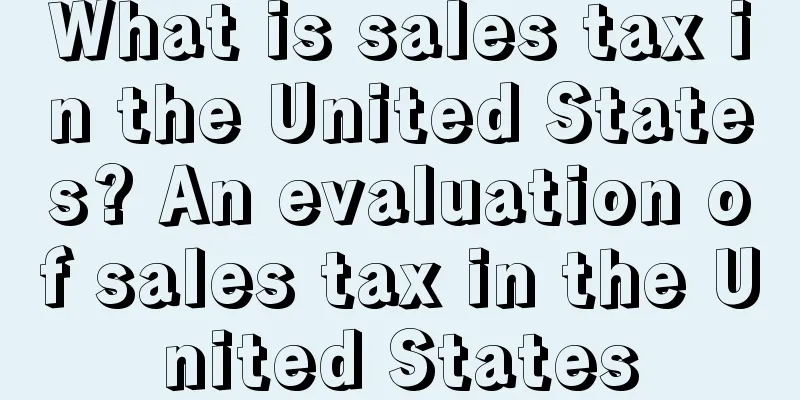What is sales tax in the United States? An evaluation of sales tax in the United States

|
Sales tax is a tax imposed by state and local governments in the United States on various goods and services at a certain percentage of their sales price. Usually, the law allows sellers to collect taxes from consumers when they purchase. Generally speaking, sales tax is a tax imposed on the retail sale of tangible personal property and the provision of certain services. Use tax is a supplement to sales tax and is usually imposed on taxpayers who purchase taxable items outside the state and bring them into the state for use, storage, or consumption. Usually, a taxable transaction is subject to either sales tax or use tax. It is worth noting that except for five specific states (Alaska, Delaware, Montana, New Hampshire, Oregon), all other states and cities will impose some level of sales tax on retail sales, rentals and leases, and related services. In addition, many cities, counties, transportation authorities, and special purpose districts will impose additional local sales taxes; the federal government in the United States does not have the authority to levy sales taxes. Taxable items The purchaser of taxable goods or services is required to pay sales tax unless the purchaser can provide the seller with a certificate stating that the purchase was tax-exempt. The tax-exempt certificate must be in a form approved by the state in question. Sales tax is levied only on the taxable income of goods or services. The tax is calculated by multiplying the tax rate by the taxable transaction amount. The tax rate varies by state and local area within a state. Latest tax rates Five states do not have a state sales tax: Alaska, Delaware, Montana, New Hampshire, and Oregon. Alaska allows localities to levy local sales taxes. The five states with the highest average combined state and local sales tax rates are Tennessee (9.55%), Louisiana (9.52%), Arkansas (9.51%), Washington (9.23%) and Alabama (9.22%). The five states with the lowest average combined rates are Alaska (1.76%), Hawaii (4.44%), Wyoming (5.33%), Wisconsin (5.43%) and Maine (5.50%). Tax returns and payments Sellers of taxable property must file a tax return with each jurisdiction in which they are required to collect sales tax. Most jurisdictions require monthly returns, but sellers with small amounts of tax to pay may file quarterly returns. Sales tax returns typically report all sales, taxable sales, sales by tax-exempt category, and the amount of tax due. If multiple tax rates are imposed (such as on different classes of property sold), these amounts are typically reported for each tax rate. Some states combine state and local sales tax returns, but many local jurisdictions require separate reporting. Some jurisdictions allow returns to be filed online. Purchasers of goods who do not pay sales tax in their jurisdiction must file a use tax return to report the taxable purchases. Many states allow such reporting to be part of an individual's income tax return. Application Requirements In most states, sales tax is collected and remitted by the seller. Use tax is assessed by the buyer. Some states require individuals or organizations that regularly engage in retail business to register as sales tax payers in the state. If a seller is required to collect sales tax in a certain area, they need to file a sales tax return in that area. Most areas require taxpayers to file tax returns monthly, and sellers with smaller amounts of tax collected can apply for longer reporting periods if they meet certain conditions. Some states allow taxpayers to file state and regional sales tax on a combined tax return, but most areas require taxpayers to file separate regional sales tax returns. Some areas allow or require taxpayers to file electronically. If the buyer has not paid sales tax in the place where the taxable goods are used, he or she will need to report and pay the use tax locally. Some states allow individuals to report the use tax directly on their personal income tax return. Tax Payment All states that impose sales taxes require sellers to remit the sales taxes they collect at least quarterly. Most states require taxpayers who exceed certain prescribed limits to remit taxes in tax periods shorter than a quarter. Some states offer sellers a tax break for paying sales taxes. |
>>: What is Surf2Ship? Surf2Ship Review
Recommend
What is SellerGrowth? SellerGrowth Review
SellerGrowth is committed to solving tax risks and...
Amazon has a new policy! It will stop accepting new customer orders!
Yesterday, according to foreign media reports, e-r...
Big news! Prime Day may be held in June? Amazon advertising bug reappears
As a partner of the world’s richest man, the Amazo...
Amid shortages of goods during peak season, American consumers' demand for gift cards surges!
It is learned that according to a survey by market...
After FBM delivery, don’t forget these three things!
The May Day holiday will start tomorrow!! This yea...
What is J&T Express? J&T Express Review
J&T Express is a technology-innovative Interne...
Big changes on Amazon! New rules for account verification and DOE certification are coming!
Amazon is not at peace this year. Just after the S...
More than 100,000 children's products were recalled! Involving Amazon, Walmart and other platforms!
It is learned that according to foreign media repo...
What is Lithium? Lithium Review
Lithium is an effective social media marketing too...
Walmart Mexico fined $4.6 million for suspected market monopoly, antitrust review continues
The Federal Economic Competition Commission (COFEC...
What is My.com? My.com Review
My.com is the international subsidiary of the Russ...
TikTok downloads reached 3 billion times in the third quarter! The number of users reached 4.5 billion!
<span data-shimo-docs="[[20,"2023年TikTok用户...
What is LivingSocial? LivingSocial Review
LivingSocial is located in Washington, D.C. It was...
Shocking! Evergreen cargo ship ran aground again, Shenzhen freight driver forged nucleic acid report!
▶ Video account attention cross-border navigation ...
What are Japanese tariffs? Japanese tariff review
Japanese tariffs are based on the import tariff ra...









